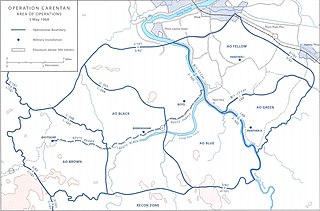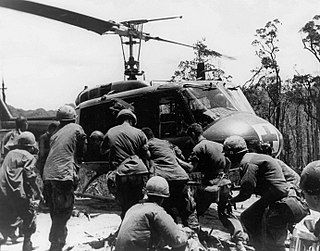
Operation Speedy Express was a controversial military operation conducted by the United States Army's 9th Infantry Division during the Vietnam War in the Mekong Delta provinces of Kiến Hòa and Vĩnh Bình. The operation, led by Major-General Julian Ewell, was part of counterinsurgency operations by the United States Armed Forces which targeted the Viet Cong (VC). U.S. forces aimed to interdict VC lines of communication and prevent Viet Cong personnel from establishing outposts in the region via the operation. The U.S. claimed the operation was successful in achieving its objectives, although the VC denied this and claimed the operation failed to stop their activities in the region.

Operation Carentan and Operation Carentan II were security operations conducted during the Vietnam War by the U.S. 1st and 2nd Brigades, 101st Airborne Division and the 3rd Brigade, 82nd Airborne Division in Thừa Thiên Province, South Vietnam from 18 March to 17 May 1968.
Operation Texas Star was a military operation of the Vietnam War that took place in Quảng Trị and Thừa Thiên Provinces from 1 April to 5 September 1970.

Operation Apache Snow was a joint U.S. Army and Army of the Republic of Vietnam (ARVN) military operation during the Vietnam War designed to keep pressure on the People's Army of Vietnam (PAVN) units in the A Sầu Valley and prevent them from mounting any attacks on the neighboring coastal provinces.

The 1st Division of the Army of the Republic of Vietnam (ARVN)—the army of the nation state of South Vietnam that existed from 1955 to 1975—was part of the I Corps that oversaw the northernmost region of South Vietnam, the centre of Vietnam.

The inauguration of Richard Nixon in January led to a reevaluation of the U.S. role in the war. U.S. forces peaked at 543,000 in April. U.S. military strategy remained relatively unchanged from the offensive strategy of 1968 until the Battle of Hamburger Hill in May which led to a change a more reactive approach. The U.S. and South Vietnam agreed on a policy of Vietnamization with South Vietnamese forces being expanded and equipped to take over more of the ground combat from the departing Americans which began to withdraw in late June without any reciprocal commitment by the North Vietnamese. The morale of U.S. ground forces began to fray with increasing racial tensions and the first instances of fragging and combat refusal. The antiwar movement in the U.S. continued to grow and public opinion turned increasingly antiwar when the Mỹ Lai massacre was revealed in November.
Firebase Fuller is a former U.S. Marine Corps, Army and Army of the Republic of Vietnam (ARVN) firebase in central Vietnam.
Operation Nevada Eagle was a security operation during the Vietnam War in Thừa Thiên Province, that took place from 17 May 1968 to 28 February 1969.
Operation Iron Mountain was a security operation during the Vietnam War in Quảng Ngãi Province, that took place from 28 February 1969 to 28 February 1971.
Operation Frederick Hill was a security operation during the Vietnam War in Quang Tin Province, that took place from 18 March 1969 to 28 February 1971.
Operation Geneva Park was a security operation during the Vietnam War in Quảng Ngãi Province, that took place from 18 March 1969 to 28 February 1971.
Operation Montgomery Rendezvous was a security operation during the Vietnam War conducted by the 101st Airborne Division in the area southwest of Huế in western Thừa Thiên Province, from 8 June to 15 August 1969.
Firebase O'Reilly is a former Army of the Republic of Vietnam (ARVN) firebase located south of Quảng Trị in Quảng Trị Province, Vietnam.
Operation Fulton Square was a joint U.S. Army and Army of the Republic of Vietnam (ARVN) military operation during the Vietnam War to engage People's Army of Vietnam (PAVN) units in the lowlands of Quảng Trị Province.
Operation Jeb Stuart III was a U.S. Army operation during the Vietnam War conducted by the 1st Cavalry Division. It took place in Quảng Trị and Thừa Thiên Provinces of I Corps, South Vietnam from 17 May to 3 November 1968.
Operation Quyet Chien, was a United States Army and Army of the Republic of Vietnam (ARVN) security operation during the Vietnam War that took place from 3 August to 31 November 1968.
Operation MacArthur was a United States Army military operation in the Central Highlands of South Vietnam from 12 October 1967 to 31 January 1969. The early phases of the operation encompassed the Battle of Dak To from 3 to 23 November 1967.
Operation Walker was a security operation conducted during the Vietnam War by the U.S. Army’s 1st Battalion, 503rd Infantry Regiment, 173rd Airborne Brigade in Bình Định Province, South Vietnam from 17 March 1968 to 31 January 1969.
Operation McLain was a security operation conducted during the Vietnam War by the U.S. Army’s 3rd Battalion, 506th Infantry Regiment, 101st Airborne Division and the Army of the Republic of Vietnam (ARVN) 44th Regiment, 23rd Division in Bình Thuận Province, South Vietnam from 20 January 1968 to 31 January 1969.
The DMZ Campaign (1969–71) was a military campaign by the United States Army, United States Marine Corps (USMC) and the Army of the Republic of Vietnam (ARVN) against the People’s Army of Vietnam (PAVN) along the Vietnamese Demilitarized Zone (DMZ) in northern Quảng Trị Province from 1969 to 1971 during the Vietnam War.




